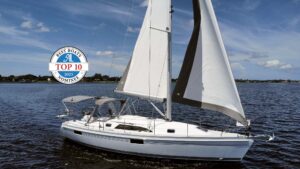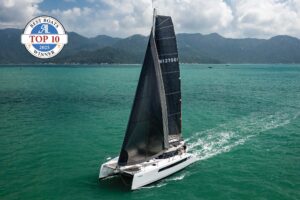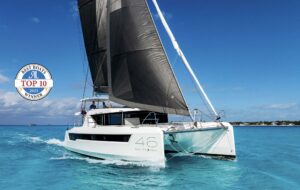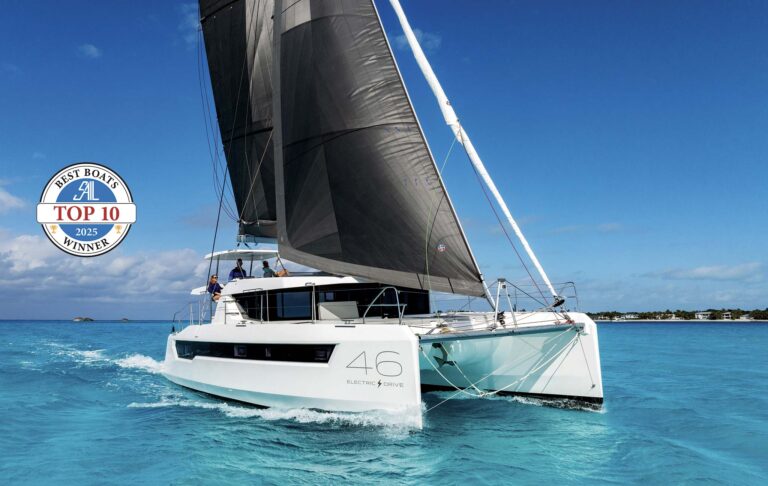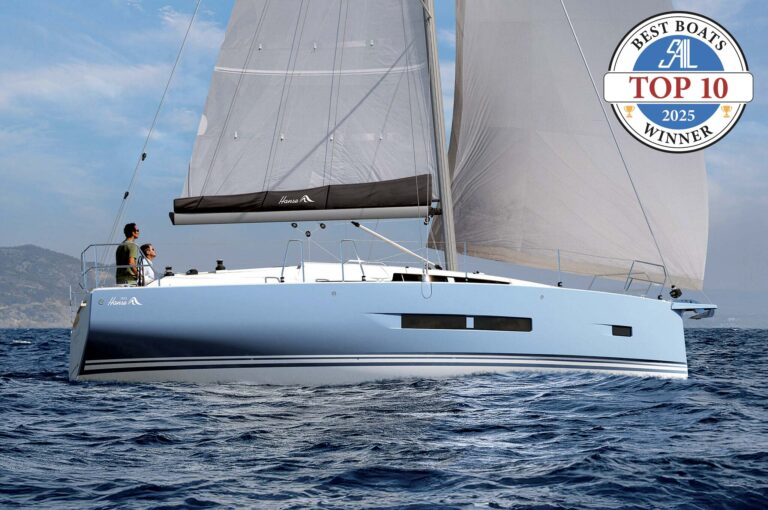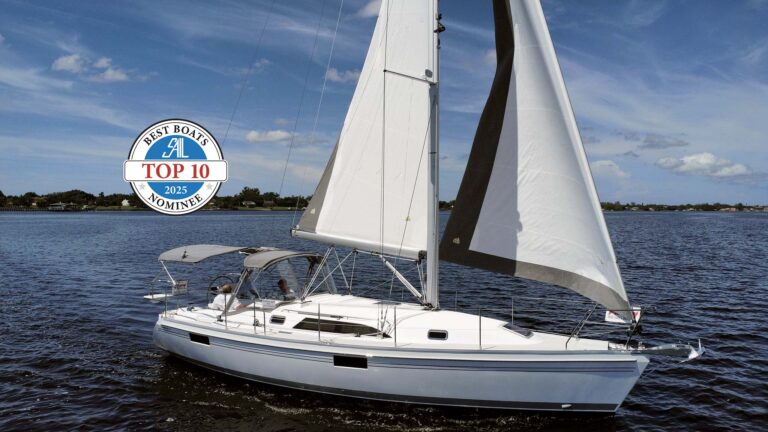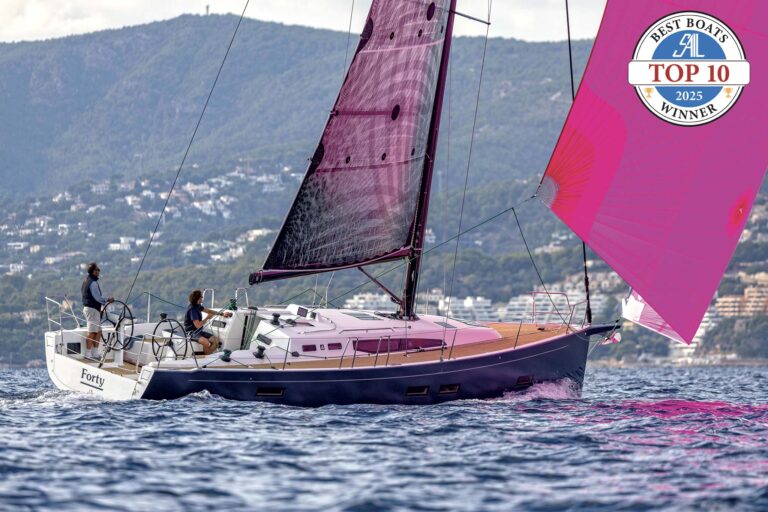
Leave it to Catana to come up with something new. This time, it’s a production 43ft catamaran that bears little resemblance to the company’s racy voyagers. They call the new boat the Bali 4.3, and it includes a host of unique features that had attendees lining up on the dock at last year’s Annapolis boat show.
DESIGN AND CONSTRUCTION
The Bali 4.3 is all about maximizing space both topsides and belowdecks. However, to retain performance, the designer made the hulls flare to distinct chines just above the waterline, so that the underwater sections would remain narrow and efficient. This also ensures plenty of reserve buoyancy, an important feature in a boat with a solid foredeck like this one.
I liked the powerplant installation. The twin Kubota diesels are mated to saildrives at their forward ends, providing excellent engine maintenance access. I could actually step down into the compartment and reach every surface of the engine—mechanics rejoice! Our test boat had a genset on a shelf in the starboard hull and was scheduled to receive a large watermaker in the same space to port.
Catana has a history of quality construction. And while the Bali line does not employ the carbon fiber reinforcement, lightweight laminate bulkheads, daggerboards and other performance enhancers that the company’s semi-custom boats are known for (in the interest of keeping costs down) it is still very well built. The hulls have balsa cores above the waterline and incorporate gray-water holding tanks in their stub keels, an interesting solution for discharge-restrictive waterways. The hulls and superstructure are constructed using vacuum infusion to ensure a lightweight but stiff layup.
Catana’s new facility in La Rochelle, France, is the source of the builder’s smaller vessels, including the Bali 4.3. The roads there limit what can be transported from the factory to a launch site, so any and all boats larger than this one continue to come from the facility at Canet-en-Roussillon. I mention this difference because our test boat, an early production model, experienced some birthing issues. More about that later.
ON DECK
The mast is stepped at the 40 percent station, giving space for a large, self-tacking Solent jib. Putting a flybridge on a boat this size necessitates a high boom and small mainsail, so the jib is a significant source of power when under sail.
The thing that makes sailors stop and stare at the Bali 4.3 is the main deck layout. Simply put, it’s a huge entertainment platform with an openness not found on other boats this size. Central to this concept is the “garage door,” a removable bulkhead enclosing the aft end of the saloon that rises electrically into the overhead to create a huge open space for fair weather and entertaining. If the weather deteriorates or you want more privacy and security, simply press a button and lower the bulkhead. There are still windows and a door in the bulkhead, but you now have a boat with an enclosed pilothouse. Pretty slick.
A slot molded into the cabintop serve as a grab rail, so moving along the side decks feels secure. That said, the boat really needs an additional rail between the forward end of the cabin top and the foredeck party pit.
Take a few steps up either side from the afterdeck, and you are on a pleasant flybridge. All the sailing controls are here, along with a comfortable helm seat, another sunbathing lounge and flush-mounted solar panels.

ACCOMMODATIONS
The three-cabin version we sailed includes plenty of privacy and accommodations for the owners in the port hull that reminded me of a compact urban apartment. The two guest cabins in the starboard hull are very pleasant as well, with dimensions more typical of a boat this size. There’s also a four-cabin charter version.
The apartment theme, which Catana calls “Loft Mode,” continues on the main deck, where there’s an unusual division of the galley space, with the cooktop and sink forward, and the household-size fridge and microwave to starboard and aft. However, counter space abounds in both areas and the layout works. For entertaining, in particular, the layout makes sense, as the serious cooking is separated from where you prepare drinks.
The forward end of the saloon is all windows, and the big central pane lowers and rises on pneumatic lifts in the bulkhead. This, in turn, makes it easy to pass out refreshments to the loungers in the foredeck cockpit.
However, while these huge expanses of glass provide excellent visibility and a sense of space, I fear they would be a liability in an offshore storm unless shutters were fitted over them. With that in mind, I see this as a coastal cruiser, not a voyager. Exploring areas like the U.S. East Coast, the Bahamas and the Caribbean, it should be delightful.
UNDER SAIL
We set the main and unrolled the asymmetric reaching headsail in a true wind of 6 to 7 knots and were rewarded with a boat speed just over 5 knots, quite a respectable performance.
Unfortunately, the steering felt springy and imprecise, and became all the more difficult sailing to windward, not from a design problem but as the result of some kind of an installation issue. Under load there were even times when the steering system bound up to a point where I was unable to hold an accurate course.
Also, the Solent jib needed a pennant at its tack to make it set properly, so that we could not point as well as we should into the wind, and the jib sheet winches were installed incorrectly and therefore difficult to use. Again, these were all installation problems that should be straightforward to fix. However, they did preclude a truly accurate assessment of the boat’s sailing ability that day. With these glitches smoothed out, I expect the Bali 4.3 to be a nice sailing boat.
UNDER POWER
We motored out of Annapolis at better than 8 knots with the engines turning at 2,500rpm, which gave us a sound level of 75 dBA in the saloon. The engine and prop combination is obviously ample for the boat.
In close quarters, the Bali 4.3 will not embarrass the skipper. It is more responsive than most cats this size, with a turning circle under one boatlength, and easily pirouettes with differential power from the engines and unusually good rudder control in reverse.
CONCLUSION
The Bali 4.3 is a thoroughly unique vessel with a breakthrough concept in living accommodations. Catana has my curiosity piqued to see what this builder comes up with next.
SA/D RATIO 19 D/L RATIO 142
What do these ratios mean? Visit sailmagazine.com/ratios

PRICE $ 490,000 (sailaway) at time of publication
April 2016

